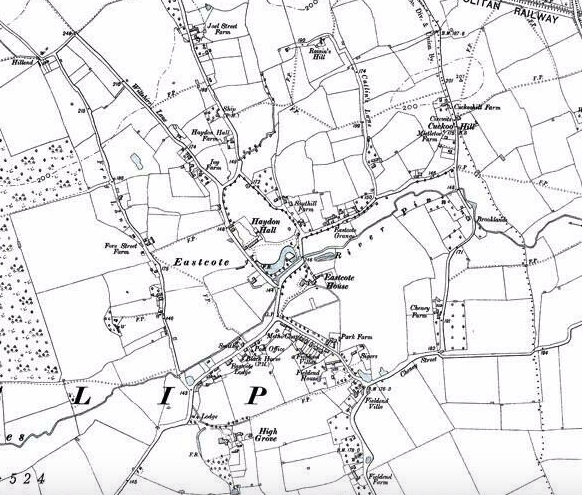27th April 2020
As we are confined to our homes during these uncertain times, the best way to make the most of it is by enjoying our local area, our doorstep and its wildlife. This has made me reflect even more on my immediate surroundings, including my own area, as well as others I have visited around London. This is the first post in a series of musings and reflections on my visits to some of the capital's fascinating neighbourhoods. This first profile is about my town, Eastcote, in the London Borough of Hillingdon.
Starting off with its wildlife, I will not be including species I have seen in my garden! There are several SINCs within Eastcote: Haydon Hall Meadows, Pinn Meadows, The River Pinn, High Grove and a section of the Yeading Brook. Other green spaces include Eastcote House Gardens, Field End Recreation Ground and a few war memorials. The Recreation Ground is home to Blackcaps, Chiffchaffs and Willow Warbler, and common species such as Greenfinch and Dunnock, with the very occasional Woodcock flying over, presumably from Ruislip Woods, where there is a small population. Eastcote House Gardens has Little Egret along the Pinn, Song and Mistle Thrushes, Nuthatches and the warbler species mentioned before. In May, I heard a Reed Warbler there! Red Kites, Buzzards, Sparrowhawks and Kestrels can often be seen flying over the town centre, and in winter, the railsides and berry bushes around the station have a large population of Redwing and Fieldfare. In summer, Swifts and Swallows nest in the lofts and eaves of houses, on roads with a lack of trees; these are few and far between, as Eastcote is a very leafy, green suburb. There are many Fox territories across the area too, but an absence of reptiles. The range of trees on Eastcote's streets is diverse, and I have been able to identify many using the fantastic TreeTalk app. The app has helped me find a rare Black Mulberry in a council estate, of which there are fewer than ten on the streets of London!

Jay
 A Little Egret crossing the River Pinn
A Little Egret crossing the River Pinn
 Fox
Fox
 Redwing at Eastcote Station
Redwing at Eastcote Station

A very, very rare Black Mulberry in a council estate!
Now onto the area's history. Eastcote is situated near to Pinner and Rayners Lane in the London Borough of Harrow, and adjacent to Ruislip and Northwood. The town's name derives from a Medieval parish known as Ascot, with modern-day Eastcote lying in the east of the parish (the local pub, The Ascott, gets its name from this). Unfortunately nothing historic has happened here, apart from at Eastcote House Gardens, where the affluent Hawtrey family, with connections to Charles I lived. The family constructed the Grade II* listed Walled Garden there, and near Warrender Park, Highgrove House became residence to a number of famous people during the early 20th Century, including Sir Winston Churchill and Victoria, Queen Consort of Sweden. In total there were three stately homes of Eastcote: Eastcote House, demolished in 1964; Haydon Hall (built for Alice, Dowager Countess of Derby), demolished in 1967; and the Grade II* listed Highgrove House. Bletchley Park set up RAF Eastcote during World War II, and GCHQ brought two Colossus decoding machines there until the organisation moved its headquarters to Cheltenham. This outpost has been demolished as well.
The Ruislip Enclosure Act of 1804 subdivided Eastcote's farmland with hedgerows, which would have been essential habitats for wildlife. This act created a twenty-foot bridleway, now known as Bridle Road: walking down it most days, I imagine that once, the hedgerows and foliage that existed beside it would have been alive with birdsong. In the 1920s, the farmland was destroyed by the dominating Metroland scheme, connecting the area to central London and making way for many tea rooms, semi-detached houses and the Eastcote Park Estate.
Map of Eastcote, 1897 (credit: Wealden Relics/eBay)
|

Entrance to the Grade II listed Walled Garden, Eastcote House Gardens
The Walled Garden
The dovecote

A Tawny Owl nestbox, Eastcote House Gardens

The Celandine Route, which connects many SINCs and green spaces along the Pinn
Warrender Park (credit: Eastcote local)
Highgrove House, the last of the three Houses of Eastcote (credit: Wikimedia Commons)
Eastcote town centre, with its new 'rain gardens' (credit: London Borough of Hillingdon)
The area is mainly residential, and the small locality of Eastcote Village is bordered by my patch, Ruislip Woods National Nature Reserve. The town centre, situated on Field End Road has recently been redeveloped, with many SuDS (Sustainable Drainage Systems), each with a variety of wildflowers: Goldfinches and many Pied Wagtails can be seen here. Eastcote Station is served by the Metropolitan and Piccadilly lines, making the commute to central London less than half an hour.
Eastcote Underground Station (Credit: Wikimedia Commons)
Visiting so many places across London has almost made me forget about the amazing wildlife in my own local green spaces, and this lockdown has taught me to explore what Eastcote has to offer: I am already surprised!
















